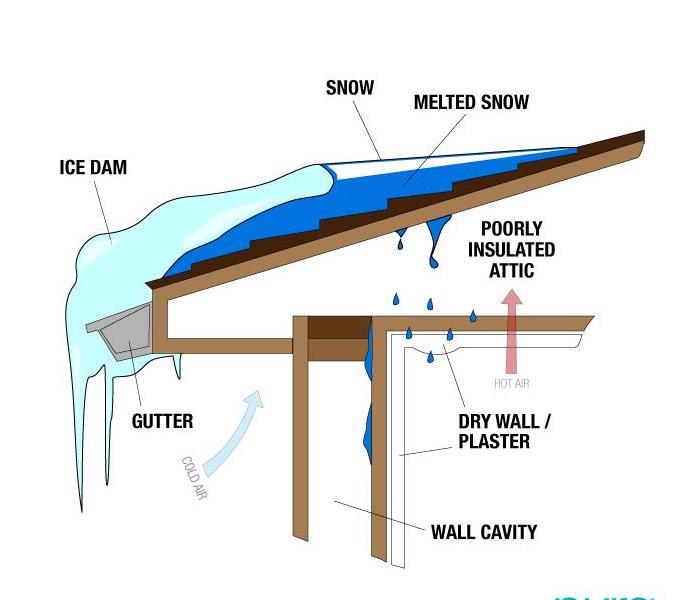What can happen after an snow/ice storm
1/5/2021 (Permalink)
When looking at roofs this winter, icicles hanging along them may look beautiful but can be very dangerous. This is because the icicles forming and snow on the roof can lead to ice dams. This is thick ridges of solid ice that build up along the eaves. Dams can tear off gutters, loosen shingles, and cause water to back up and pour into the building or home. In result, this can lead to peeling paint, warped floors, stained and sagging ceilings. Also, soggy insulation in the attic, which loses R-value and becomes a magnet for mold and mildew.
Here are some ways in order to prevent ice dams. The first is to use heated cables. Attach these with clips along the roof's edge in a zigzag pattern, and the heated cables help prevent ice dams that lift shingles and cause leaks. This solution allows you to equalize your roof's temperature by heating it from the outside instead of blowing in cold air from the inside.
Next is to blow in cold air. Hacking away at ice dams with a hammer, chisel, or shovel is BAD for your roof. Also, throwing salt on them will do more harm to your plantings than the ice. Therefore, take a box fan into the attic and aim it at the underside of the roof where water is actively leaking in. This targeted dose of cold air will freeze the water in its tracks.
You can also rake it by pulling off snow with a long-handled aluminum roof rake while you stand safely on the ground. A rake with wheels will instantly change the exterior temperature of your roof without damaging shingles.
De-icing methods deal with diminishing the damage after the dam has formed. Fill the leg of a discarded pair of panty hose with a calcium chloride ice melter. Lay the hose onto the roof so it crosses the ice dam and overhangs the gutter. You can use a long-handled garden rake or hoe to push it into position. The calcium chloride will eventually melt through the snow and ice and create a channel for water to flow down into the gutters or off the roof.
Lastly is a permanent fix for ice dams. Getting ride of ice dams for good is simple. Just keep the entire roof the same temperature as the eaves. This is done by increasing the ventilation, adding insulation, and sealing off every possible air leak that might warm the underside of the roof.
1. Ventilate Eaves and Ridge
- A ridge vent paired with continuous soffit vents circulates cold air under the entire roof. Both ridge and soffit vents should have the same size openings and proved at least 1 square foot of opening for every 300 square feet of attic floor. Place baffles at the eaves to maintain a clear path for the airflow from the soffit vents.
2. Cap the Hatch
- An unsealed attic hatch or whole-house fan is a massive opening for heat to escape. Cover them with weather stripped caps made from foil-faced foam board held together aluminum tape.
3. Exhaust to the outside
- Make sure that the ducts connected to the kitchen, bathroom, and dryer vents all lead outdoors through either the roof or walls, but never the soffit.
4. Add insulation
- More insulation on the attic floor keeps the heat where it belongs. To find how much insulation your attic needs, check with your local building department.
5. Install sealed can lights
- Old-style recessed lights give off great plumes of heat and can't be insulated without creating a fire hazard. Replace them with sealed "IC" fixtures, which can be covered with insulation.
6. Flash around chimneys
- Bridge the gap between chimney and house framing with L-shaped steel flashing held in place with unbroken beads of a fire-stop sealant. Using canned spray foam or insulation isn't fire safe.
7. Seal and insulate ducts
- Spread fiber-reinforced mastic on the joints of HVAC ducts and exhaust ducts. Cover them entirely with R-5 and R-6 foil-faced fiberglass.
8. Caulk penetrations
- Seal around electrical cables and vent pipes with a fire-stop sealant. Also, look for any spots where light shines up from below or the insulation is stained black by the dirt from passing air.
Understanding the lifecycle of ice damming is key. It starts with the birth, and it is the breakdown of the conditions that lead to the formation of ice dams. First, heat collects in the attic and warms the roof, except at the eaves. Next you move into the growth, and snow begins to melt on the warm roof and then freezes on the cold eaves. Finally is maturity, and ice accumulates along the eaves, forming a dam. Meltwater from the warm roof backs up behind it, flows under the shingles, and into the house.






 24/7 Emergency Service
24/7 Emergency Service
